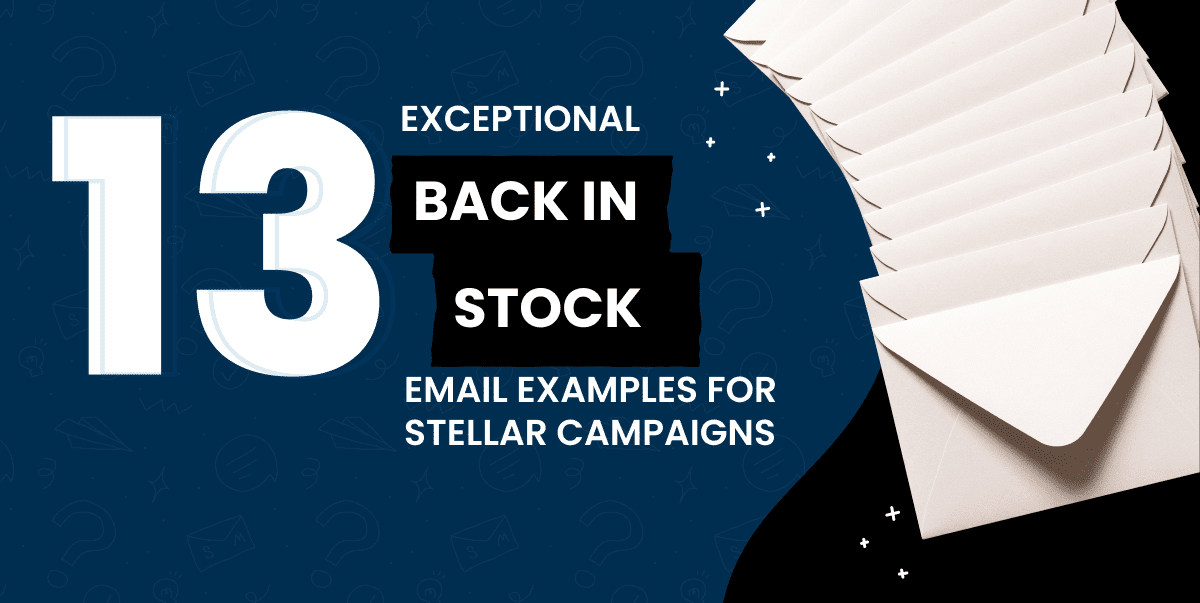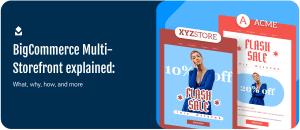Welcome to our curated list of 13 Exceptional Back in Stock Email Examples for Stellar Campaigns. In the world of e-commerce, it’s the little things that can make a big difference. One such thing is the often-overlooked Back in Stock email notification.
So, what does it take to create compelling back in stock emails that actually work? A mix of smart strategies, engaging design and copy, and just the right timing can make all the difference.
We’re showcasing thirteen top-notch back in stock email examples from successful brands. Each one is a source of great inspiration, whether you’re just starting out or looking to improve your existing back in stock email strategy. But first let’s answer a few frequently asked questions!
What is a back in stock email?
A back in stock email is an automated message that’s triggered and sent to customers when an item that was previously out of stock is available again. These emails are crucial for driving conversions, especially in scenarios where customers have shown interest in a particular product but were unable to purchase due to its unavailability. In other words, it’s an easy way to tap into a ready pool of potential customers who’ve already shown interest in a product. We also know that Back in Stock emails have the highest open rate at an average of a staggering 65.32%! Thanks to this comprehensive 2023 email marketing ROI Statistics report
How to write a back in stock email?
Writing an effective back in stock email requires a blend of timely communication, attractive presentation, and a clear call to action. Here’s a basic formula you can follow:
- Start with an attention-grabbing subject line, for example: “Good news! Your favorite [product name] is back in stock!”
- Inside the email, be sure to acknowledge their interest in the product and announce that it’s now back in stock.
- Provide a clear image of the product to refresh their memory and stir their interest.
- Add a direct call to action that takes them to the product page, for instance: “Shop Now” or “Get It Before It’s Gone”.
- Optionally, you can add some urgency or exclusivity to motivate immediate action. You can mention limited stock, high demand, or limited time availability.
Are back in stock emails transactional?
Not quite. Back in stock emails are technically triggered marketing emails, as they’re based on the behavior of the customer (expressing interest in a product that was out of stock). However, they’re not transactional emails like order confirmations or shipping notifications, which are directly related to a customer’s transaction. Back in stock emails can walk a fine line as they’re sent based on a customer’s interaction with a product but are not triggered by a purchase. Their primary goal is promotional—to drive the customer back to the store to make a purchase.
It’s time to see theory in practice, drawing from successful strategies implemented by various brands. The best way to learn is often by observing others, understanding their approaches, and then tailoring those insights to our unique contexts.
Back In Stock Email Examples
Each of these campaigns has been handpicked for their strategic brilliance, showcasing a myriad of tactics, from creating a sense of urgency to employing captivating visuals, offering exclusive access, and more.
As we dissect these examples, we’ll draw out the key strategies and techniques that make them so effective. It’s not just about announcing a product’s return; it’s about seizing the opportunity to re-engage, re-excite, and reconvert.
Keep in mind, the goal here isn’t to clone these emails, but to draw inspiration from them and adapt their winning elements to suit your brand’s unique voice and audience.
1) Margin’s elegant Back in Stock Email
Creating simple yet elegant emails that capture the readers attention and delivers the right information can be a fine line to balance. Margin have been able to effectively roll all these features into their Back in Stock email with ease.
By using a simple font on a contrasting background makes this email easy to to read, especially on smaller screens. This is something to consider with more customers reading emails on their mobile devices than ever before.
The offer of “Today Only” complimentary shipping encourages customers to act quickly as well as increasing the value to the customers purchase.

Key takeaway: Complimentary shipping enhances the value proposition for the customer. By absorbing the shipping cost, Margin removes a common barrier to online purchases and makes the deal more attractive, thereby increasing the likelihood of a sale.

2) Patagonia
Patagonia’s Back in Stock email is an excellent example of effective customer communication, weaving together several key strategies seamlessly. The email begins by placing their brand name prominently at the top, immediately sparking recognition and engagement among readers. Their direct call-to-action, urging customers to “get it while we still have it”, injects a sense of urgency, encouraging prompt purchasing decisions.
The star of the email, the Men’s Houdini Jacket, is thoughtfully presented with a brief yet informative description and clear pricing, making it straightforward for customers to gauge their interest and make their buying decisions. Beyond just selling a product, Patagonia also takes this opportunity to highlight their dedication to environmental preservation, pledging 1% of sales towards this noble cause since 1985. This not only appeals to the growing base of socially-conscious consumers but also strengthens brand loyalty by demonstrating that every purchase contributes to a larger purpose.
Rounding off the email is Patagonia’s ‘Ironclad Guarantee’, a commitment to repair wear and tear damages at a reasonable charge. This reassuring promise serves to inspire confidence in the product’s durability and the brand’s customer service, reinforcing trust and customer satisfaction. With its blend of urgency, clear product information, brand legacy, environmental commitment, and customer assurance.
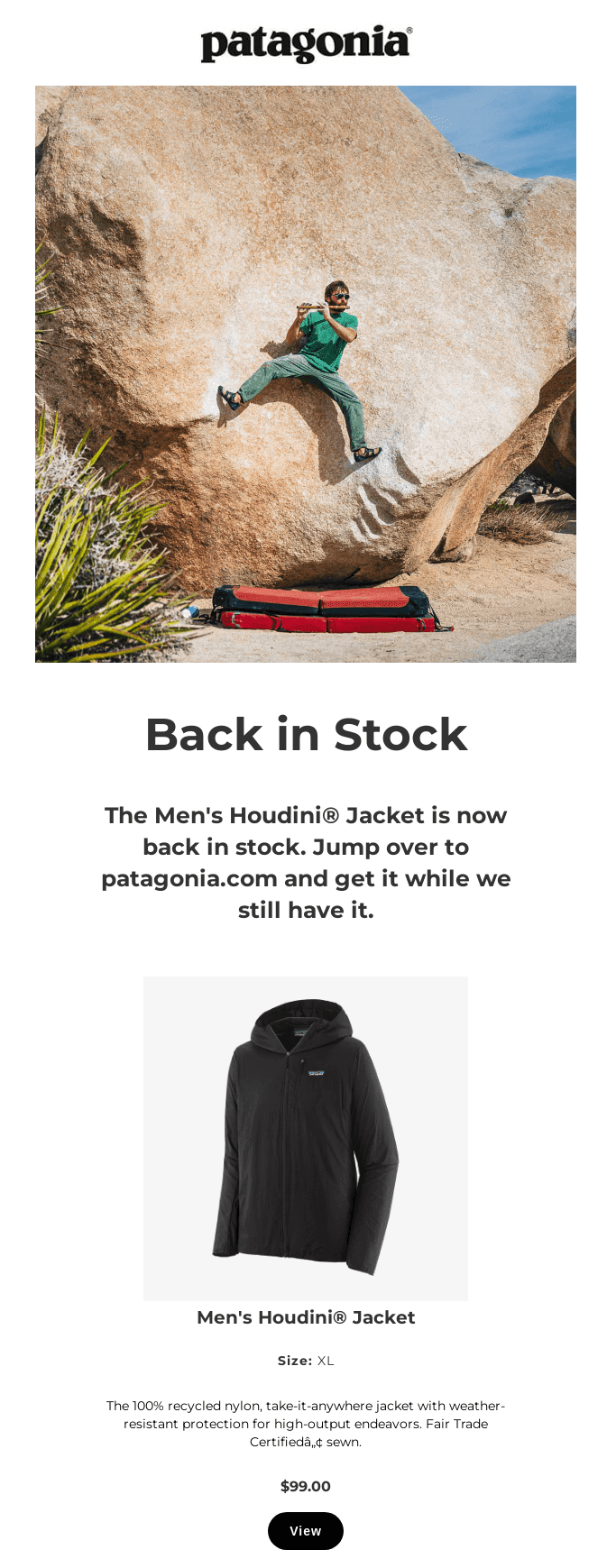
Key takeaway: Don’t be put off by the importance of blending several key elements to create a compelling and effective communication piece.
3) Hero’s first access Back in Stock email
Showcasing an expertly crafted ‘back in stock’ notification, Hero masterfully leverages urgency, exclusivity, and visual appeal to re-engage their customers. This cleverly-designed email marries an enticing ‘back by popular demand’ tagline with an exclusive 24-hour early access offer, fostering both desirability and immediate action.
The visually striking hero image serves as a powerful reminder of the product, while a clear ‘Shop Now’ button, coupled with strategically placed links to various brand resources, smoothly guides customers on their shopping journey. Overall, it’s a perfect example of how to convert anticipation into sales while enhancing brand loyalty.

Key takeaway: Recognising that the customers have been “patiently waiting” for the restock acknowledges their desire and anticipation, making an emotional connection that makes customers feel seen and valued.
4) Sproos’ to the point Back in Stock email
Sproos’ ‘red is back!’ Back in Stock email doesn’t beat around the bush when it comes to delivering their key takeaway; Informing their customers that their Red Showers are back in stock, whilst creating a sense of urgency!
Keeping their email on theme with the product by using the colour red consistently in their design with the juxtaposition of the attention grabbing purple text, draws readers right in.
Building on the sense of community, the use of a specific hashtag encourages customers to share their experiences, fostering interaction both with the brand and among customers on social media. Alongside, a clear and prominent call-to-action guides the customer journey, making the purchasing process straightforward and customer-friendly.

Key takeaway: When most emails use complimentary colours, stand out from the crowd and try something different.
5) Janji ‘s fun Back in Stock Email
Janji’s ‘Back in Stock’ email for their ‘Multipass Sling Bag’ stands out as a visually compelling piece that skillfully deploys several effective strategies. The eye-catching orange background paired with playful cartoon drawings immediately captures attention, setting the stage for the rest of the email.
The email stirs excitement by announcing the return of a “favourite accessory” and reinforcing this sentiment with the “bestseller restock” tagline. This approach subtly emphasizes the high demand and desirability of the product, making it all the more enticing.
Building on this, Janji cleverly instills a sense of urgency with the phrase “get it before it sells out again”, nudging customers towards quick purchase decisions. The clear and compelling call to action, ‘Shop the Sling Bag’, serves as a direct guide, making the path to purchase straightforward and convenient.
Closing the email with their brand motto, “connecting the world through running,” Janji reaffirms their brand purpose, subtly appealing to customers who share similar values and fostering a deeper connection with their audience.
All in all, Janji’s ‘Back in Stock’ email seamlessly blends engaging visuals, a sense of urgency, clear direction, social proof, and brand purpose to create a persuasive and effective customer communication.

Key Takeaway: Adding credibility to your message offer social proof of the product’s quality and appeal.
6) Radio Roasters Coffee
Radio Roasters Coffee’s ‘Back in Stock’ email serves as a standout example of effective customer communication, adeptly blending key strategies for optimal impact. The visually pleasing and cohesive design, with a light yellow backdrop echoing the color of the product itself, creates an engaging aesthetic that draws the eye directly to the star of the show – the steeped coffee single serve bags.
A concise, yet evocative, product description serves to remind customers of the unique features and benefits of the product, thus reigniting their interest and stoking the desire to make a purchase. The clear and prominent ‘Shop Now’ button simplifies the customer journey, providing an easy, intuitive pathway towards conversion, and eliminating any potential obstacles in the purchasing process.
Yet what sets this email apart is its subtle use of cross-selling. By showcasing new arrivals, and notably, a highly relevant cross-sell item – a vacuum canister for coffee beans – Radio Roasters Coffee cleverly extends the customer interaction beyond a single transaction. By offering a solution for keeping beans fresh, they add value to the purchase and foster customer satisfaction.

Key takeaway: Consider using your Back in Stock email as an opportunity to upsell to customers who are ready to buy
7) Bloomscape
The moment you open Bloomscape’s email, you are greeted with an unmissable, bold “Back in Stock!” headline. It leaves no room for confusion, ensuring the reader knows exactly what the message is about. This effective directness hooks the reader from the get-go.
Bloomscape goes a step further by acknowledging customer feedback with the phrase, “You asked, we listened!” The simple act of conveying that they value and act on their customers’ input can significantly strengthen emotional connections and make customers feel integral to the brand’s decisions.
In the world of e-commerce, creating a sense of urgency and exclusivity can drive action. Bloomscape achieves this by stressing that their Trandescantia Nanouk plant, a bestseller from February, is back “for a limited time.” This nudge can motivate customers to make a swift purchase to avoid missing out.
The captivating visual appeal of the email can’t be overlooked. A high-quality, aesthetically pleasing photograph of the plant not only showcases the product in its full glory but also intrigues the reader’s eye, potentially fueling their desire for the product.
Bloomscape understands that the key to persuading customers to buy is to arm them with useful information. Quick facts about the plant, its benefits, and a link to a handy care guide can help potential buyers feel more confident and informed in their decision.
The ‘Shop Now’ button is strategically placed and clearly visible, facilitating a smooth journey towards conversion. The cohesive use of dark and light green colors throughout maintains brand identity and makes the overall design pleasing to the eye.
Bloomscape doesn’t stop at just announcing the restock. The email also includes compelling reasons to buy the plant, reinforcing its value and appeal. And with links to the rest of their store included, Bloomscape encourages further exploration of their offerings, increasing the chances of additional purchases.

Key takeaway: Emulate Bloomscape’s effective strategy in your own ‘Back in Stock’ emails by blending a clear and direct message, a sense of urgency, appealing visuals, useful product information, and upselling opportunities. This combination will help engage your customers, reinforce your brand value, and encourage immediate action.
8) DJI
DJI demonstrates a masterclass in back-in-stock emails with their announcement for the DJI Inspire 3. The email immediately captures attention with an exhilarating snapshot of the drone in action, cleverly hinting at the thrill of ownership. The message is crystal clear and impossible to miss – the DJI Inspire 3 is back in stock and ready for ‘pro-level productions’.
In one succinct line, DJI crafts a sense of urgency, cleverly nudging customers to make a prompt purchase decision to avoid disappointment. A bold ‘Shop Now’ button reinforces this call-to-action, practically ushering customers toward the checkout.
Yet DJI doesn’t stop at a simple product announcement. They supplement their email with additional product information, giving customers a deeper understanding and more reasons to choose the Inspire 3. Meanwhile, by highlighting a selection of other items, DJI cleverly uses this opportunity to cross-sell and potentially elevate the total purchase value.
Underpinning all these sales strategies is DJI’s emphasis on customer benefits. They draw attention to the perks of shopping with them, such as the 1% DJI credit reward offer, swift delivery options, and the availability of officially refurbished products. These benefits are more than mere sales pitches; they’re an affirmation of DJI’s commitment to customer value and service.
Lastly, the email ends with an invitation to engage with DJI across social media platforms, fostering a sense of community around the brand. All these elements together form a back-in-stock email that not only communicates product availability, but also boosts customer engagement, enhances brand loyalty, and drives sales.

Key takeaway: Leverage the power of appealing visuals and a clear call-to-action, as DJI does, in your back-in-stock emails. Additionally, augment your emails with valuable product information, cross-selling opportunities, and clear customer benefits. Also, don’t forget to invite your customers to engage on social media, helping foster a community around your brand. This multifaceted approach not only informs customers about the product but also promotes engagement, builds loyalty, and encourages purchases.
9) Sonos
Sonos’ back in stock email is highly effective due to its visual appeal, clear messaging, and focus on customer service. The email immediately grabs attention with a vibrant graphic illustration of a living room filled with Sonos speakers, setting the scene for a more immersive sound experience. The headline, “the wait is over,” conveys urgency and excitement, further amplified by the promise of free shipping, which can incentivize immediate purchase.
The email then transitions into a grey block that spotlights the back-in-stock product along with a ‘shop now’ button, which serves as a clear and direct call-to-action. The display of the product itself allows customers to visualize what they’ve been waiting for, creating a sense of desire and impatience to own the product.
What sets this email apart, however, is Sonos’ focus on customer service. The brand emphasizes their commitment to customer satisfaction by offering free shipping, easy returns, and full-time support. The presence of a ‘contact us’ link reassures customers that help is readily available, fostering trust in the brand. Overall, Sonos’ back-in-stock email effectively re-engages customers, promoting immediate purchases while highlighting the brand’s commitment to customer satisfaction.
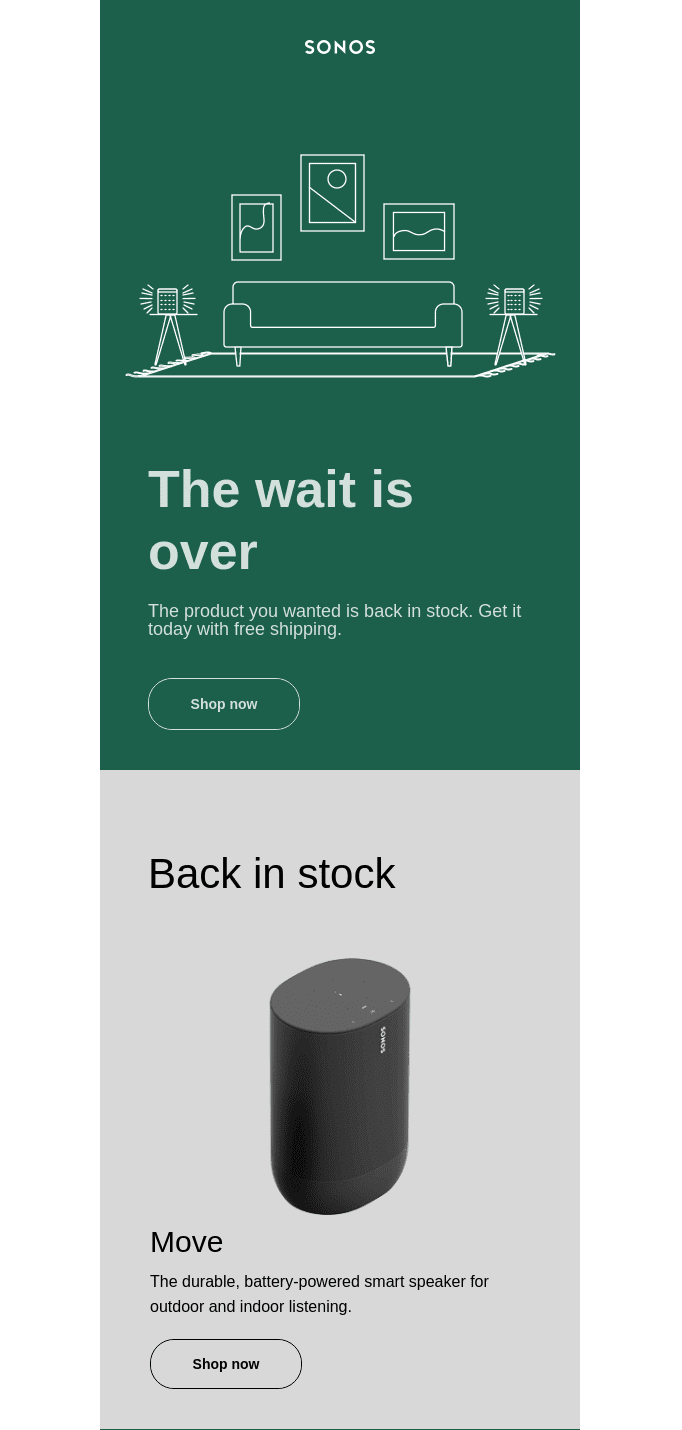
Key Takeaway: Emphasise on excellent customer service in your back in stock emails like Sonos. Alongside exciting visuals and clear messaging, assurance of free shipping, easy returns, and full-time support can significantly foster customer trust and incentivise immediate purchases.
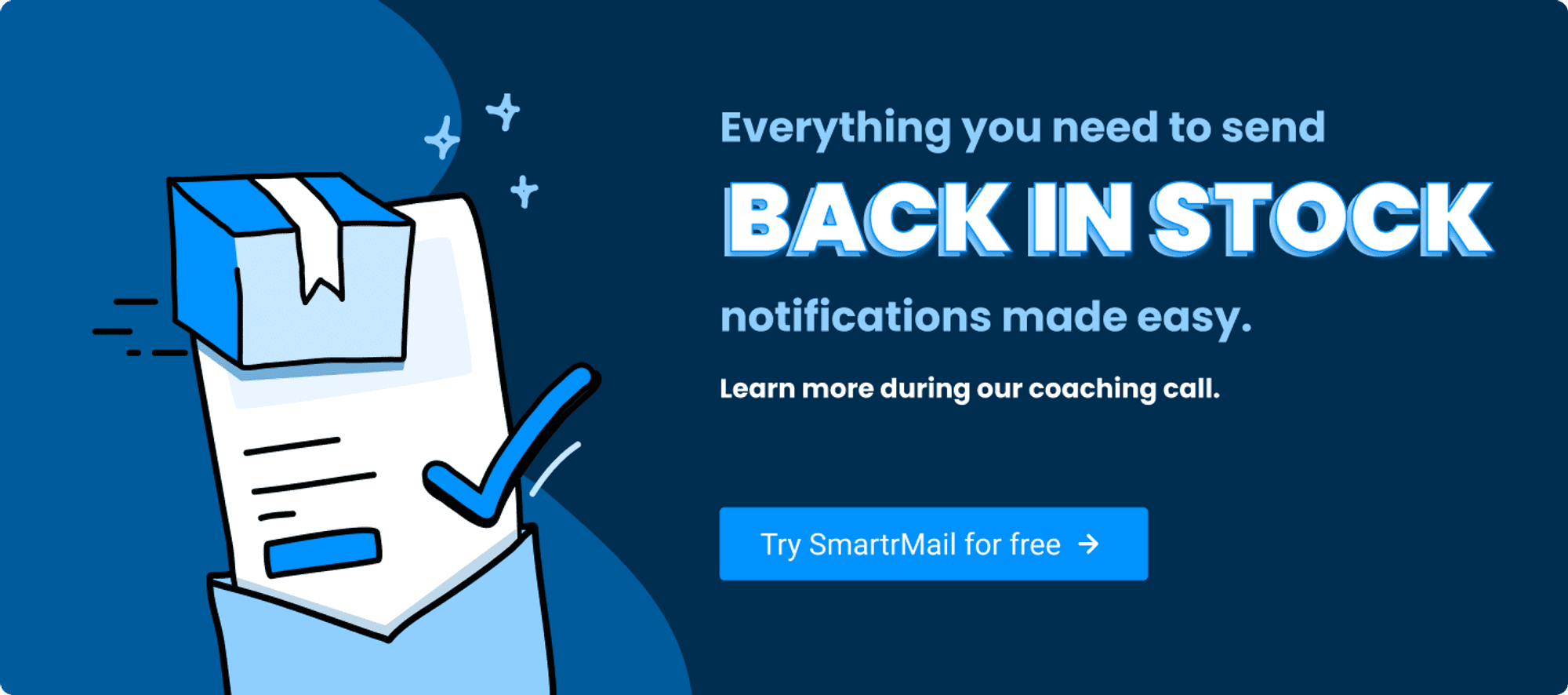
10) Happy Happy Houseplant
Happy Happy Houseplants’ back in stock email is a superb blend of relatability, personalisation, and clever use of visuals. Starting with a warm image of a smiling lady wearing the product that is back in stock, it instantly connects the customer to the product, conveying how it would look and feel to wear the sweatshirt.
The black text on a yellow background, “our faves are back!,” is eye-catching and informative, inciting curiosity about the product’s popularity. The accompanying blurb personalises the message, suggesting that the company listens to its customers’ needs, here being a greater range of sizes. This sense of individual attention enhances customer trust and satisfaction, increasing the chances of them wanting to shop.
Links to different variants of the sweatshirt provide easy access to alternatives, reducing the effort needed to browse the site and enhancing the shopping experience. The email effectively makes the customer feel valued, seen, and heard while showcasing the available product options, increasing the likelihood of immediate purchases and future customer loyalty.

Key Takeaway: Foster a personal connection with your audience like Happy Happy Houseplants. Use relatable visuals, show responsiveness to customer needs, and provide easy access to product variants in your back-in-stock emails to enhance customer trust and make the shopping experience enjoyable and effortless.
11)Haus
Haus’s back in stock email for their Lemon Lavender product masterfully combines beautiful visuals, concise yet evocative descriptions, and a simple, clear call to action to draw in the reader. Starting with a clean, bold heading that immediately announces the return of the beloved Lemon Lavender, the email then presents an attractive image of the product, allowing customers to visualise what they can soon have in hand.
The concise product description beneath the image offers just enough detail to intrigue without overwhelming, and the prominent “Shop Lemon Lavender” button leaves no ambiguity about the next step a customer should take. A highlighted review on a purple block adds social proof to the mix, increasing the email’s persuasive power.
The addition of more detailed information about the ingredients not only provides potential buyers with insight into the product’s unique qualities but also emphasizes the care and quality that go into Haus’s offerings. The repeat “Shop Lemon Lavender” button further reinforces the desired action, while the concluding “Cheers” and prominent “Haus” sign off lend a friendly, personal touch.
Finally, the inclusion of social links offers readers further avenues to engage with the brand. This back in stock email does an excellent job of grabbing attention, building interest and desire, and guiding customers towards the purchase, making it an effective tool in the brand’s marketing arsenal.

Key Takeaway: Haus’s back in stock email offers an effective strategy: blend beautiful visuals with detailed yet digestible product descriptions, incorporate social proof, and clearly signpost the path to purchase. Concluding with a personal touch and providing additional engagement avenues reinforces the brand’s appeal and nurtures customer relationships.
12) Wonder Valley
Wonder Valley’s ‘Back in Stock’ email for their Hinoki Body Oil presents a splendid example of effective marketing communication. The overall design is visually arresting, starting with a yellow background that pops and their brand name contrasted against a beautifully dim-lit image of the featured product. The words “Back in Stock: Hinoki Body Oil” unambiguously announces the product’s return and acts as a call to action to the reader.
The email then delves into a brief message emphasizing the oil’s benefits, engaging the customer’s interest and subtly building a case for why the product is a must-have. This is further reinforced by a second image showing the product in use, a strategy that helps readers to visualize how they might use the product.
Below the picture, a comprehensive list of benefits serves to further justify the product’s value, and a clear, distinct ‘Buy’ button provides an effortless next step for the intrigued reader. The addition of a review not only validates the product but also provides social proof, effectively persuading readers of the product’s worthiness.
The black trim around the email frames the content beautifully, drawing the reader’s attention inward, and image links to other products at the bottom serve as cross-selling opportunities. These factors all contribute to make this a highly effective back in stock email, designed to re-engage customers, enhance their desire for the product, and ultimately drive sales.

Key Takeaway: Wonder Valley’s back in stock email effectively leverages bold visuals, a clear message, in-use product imagery, and compelling social proof. Emphasising product benefits and providing a straightforward call-to-action can amplify customer interest and drive sales, while well-placed cross-selling opportunities can further enhance customer value.
13)Haus
Quince’s ‘Back in Stock’ email takes a minimalist and straightforward approach that’s both eye-catching and efficient. Leveraging a clean, white background with contrasting black text, the email immediately draws attention to their brand name and the announcement, “Did you hear? It’s back in stock.” This simple yet engaging headline helps to pique reader interest right from the start.
Following the headline, a crisp image of the Ultra-Soft Performance Legging is presented, giving customers a clear view of the product. Accompanied by a concise description and a visible price, it provides all necessary information in an easy-to-digest format. The ‘Shop Now’ button, placed strategically next to the product, allows interested customers to act promptly and make a purchase.
The email goes a step further to re-engage customers by showcasing other products that are also back in stock, followed by a ‘Recommended for you’ section. These elements not only promote additional products but also personalize the customer’s experience, enhancing their engagement with the brand.
Closing out with their sustainability information and customer-friendly policies, like free shipping, 365-day returns, and a $20 referral reward, the email effectively reinforces Quince’s commitment to customer satisfaction and responsible business practices. The simplicity and clarity of the email, coupled with its effective use of product promotion and policy information, make this a prime example of an effective back in stock email.

Key Takeaway: Quince’s ‘Back in Stock’ email illustrates the power of a clean, minimalist design combined with clear messaging and strategic promotion of other products. Emphasising customer-friendly policies and sustainability initiatives within the email can further enhance brand image and trust, making it a more persuasive communication tool.
3 Best practices for Back in Stock Emails
- Personalise the Communication: Tailor your back in stock emails to match the recipient’s interests and past behaviours. If a customer signed up for an alert for a specific product, ensure that the email content is highly relevant to that product. Using their name in the email and mentioning the specific product will make the communication feel more personal and targeted, increasing the chance of a positive response.
- Use Clear and Exciting Subject Lines: Your subject line should instantly convey that the product your customer has been waiting for is now available. You might consider adding a sense of urgency (e.g., “Hurry, your favorite product is back in stock!”) or using excitement-inducing language (e.g., “Great news! Your awaited product is here!”). Make sure your subject lines are catchy and straight to the point to improve open rates.
- Implement Visually Appealing Design and Clear CTAs: A picture is worth a thousand words – include high-quality images of the product that’s back in stock to remind your customer why they wanted it in the first place. Also, make sure your call-to-action (CTA) buttons are clear and conspicuous. A bright, easy-to-find “Buy Now” button can significantly increase click-through rates and, ultimately, conversions.
Remember, every email you send is an opportunity to strengthen your relationship with your customers. These best practices for Back in Stock emails should not only notify customers about product availability but also enhance their experience with your brand.
Building Your Own Back in Stock Email Campaign
We’ve seen how a solid Back in Stock email can do wonders for engaging customers and bumping up those sales. Whether it’s playing up the exclusivity card like Hero or going all in with a bold design like Sproos, each brand has their unique flavor, and so should you.
The secret sauce? Tailoring your emails to your brand’s vibe, your product’s special features, and, of course, what your customers dig.
One part of the magic formula is your email’s subject line – it’s like the welcome mat to your message. Nail it right, and you’ve got an invitation too good to ignore. Need inspiration? Check out our post on killer Back in Stock subject lines to get those creative juices flowing.
And as you get deeper into creating your Back in Stock email campaign, you might want to level up your game. Timing, automation, tracking your success – yeah, it can feel like a lot. But don’t sweat it. Our comprehensive guide, ‘Everything You Need to Know about Back in Stock Emails’, has got your back.
Remember, Back in Stock emails are more than just a heads-up about available products. It’s your chance to show off your brand, build relationships, and get people excited. So, take a breather, think about what your audience would love, and craft emails that’ll turn heads. Happy emailing!

